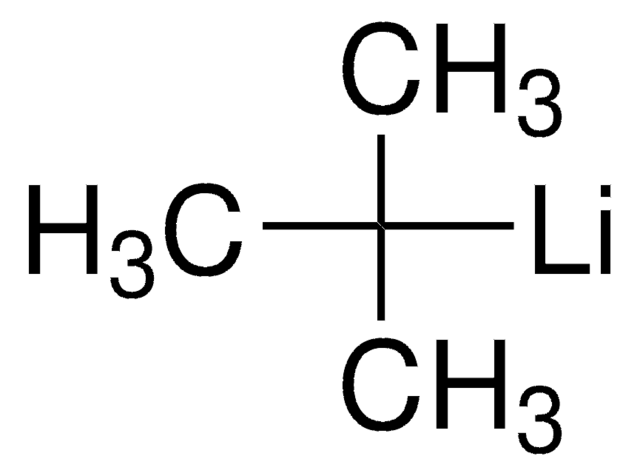Products may be shipped at a different temperature than the recommended long-term storage temperature. If the product quality is sensitive to short-term exposure to conditions other than the recommended long-term storage, it will be shipped on wet or dry-ice. If the product quality is NOT affected by short-term exposure to conditions other than the recommended long-term storage, it will be shipped at ambient temperature. As shipping routes are configured for minimum transit times, shipping at ambient temperature helps control shipping costs for our customers. For more information, please refer to the Storage and Transport Conditions document: https://www.sigmaaldrich.com/deepweb/assets/sigmaaldrich/marketing/global/documents/316/622/storage-transport-conditions-mk.pdf
186171
n-Butillitio
1.6 M in hexanes
Sinonimo/i:
n-BuLi, Butillitio, Litio-1-butanide
About This Item
Prodotti consigliati
Stato
liquid
Livello qualitativo
Concentrazione
1.6 M in hexanes
Densità
0.68 g/mL at 25 °C
Temperatura di conservazione
2-8°C
Stringa SMILE
[Li]CCCC
InChI
1S/C4H9.Li/c1-3-4-2;/h1,3-4H2,2H3;
MZRVEZGGRBJDDB-UHFFFAOYSA-N
Cerchi prodotti simili? Visita Guida al confronto tra prodotti
Applicazioni
- Copolimerizzazione di butadiene e stirene in presenza di n-butillitio: Questo studio esplora il processo di copolimerizzazione utilizzando l'n-butillitio come catalizzatore, che è significativo per lo sviluppo di nuovi materiali di gomma sintetica (V Bronskaya et al., 2023).
- Modificatori del n-butillitio nella sintesi di gomme polibutadiene e stirene-butadiene: Esplora l'uso dell'n-butillitio con diversi modificatori nella sintesi di gomme industriali, importante per la comprensione del controllo sulle proprietà dei polimeri (VS Glukhovskoi et al., 2014).
- Aggregazione e solvatazione del n-butillitio: Esamina il comportamento di aggregazione e le proprietà di solvatazione del n- butillitio in vari solventi, fornendo approfondimenti sulle interazioni chimiche essenziali per la sintesi organica (O Tai et al., 2017).
Confezionamento
Il flacone Sure/Seal™ da 25 mL è consigliato come flacone monouso. È probabile che perforazioni ripetute determino una riduzione delle prestazioni del prodotto.
Altre note
Note legali
Prodotti correlati
Avvertenze
Danger
Indicazioni di pericolo
Classi di pericolo
Aquatic Chronic 2 - Asp. Tox. 1 - Eye Dam. 1 - Flam. Liq. 2 - Pyr. Liq. 1 - Repr. 2 - Skin Corr. 1B - STOT SE 3 - Water-react 1
Organi bersaglio
Central nervous system
Rischi supp
Codice della classe di stoccaggio
4.2 - Pyrophoric and self-heating hazardous materials
Classe di pericolosità dell'acqua (WGK)
WGK 3
Punto d’infiammabilità (°F)
-14.8 °F - closed cup
Punto d’infiammabilità (°C)
-26 °C - closed cup
Scegli una delle versioni più recenti:
Possiedi già questo prodotto?
I documenti relativi ai prodotti acquistati recentemente sono disponibili nell’Archivio dei documenti.
I clienti hanno visto anche
Articoli
Transformative reagents enable selective conversions within molecules containing sensitive functionalities under mild reactions.
-
How is shipping temperature determined? And how is it related to the product storage temperature?
1 answer-
Helpful?
-
-
How can I determine the shelf life / expiration / retest date of this product?
1 answer-
If this product has an expiration or retest date, it will be shown on the Certificate of Analysis (COA, CofA). If there is no retest or expiration date listed on the product's COA, we do not have suitable stability data to determine a shelf life. For these products, the only date on the COA will be the release date; a retest, expiration, or use-by-date will not be displayed.
For all products, we recommend handling per defined conditions as printed in our product literature and website product descriptions. We recommend that products should be routinely inspected by customers to ensure they perform as expected.
For products without retest or expiration dates, our standard warranty of 1 year from the date of shipment is applicable.
For more information, please refer to the Product Dating Information document: https://www.sigmaaldrich.com/deepweb/assets/sigmaaldrich/marketing/global/documents/449/386/product-dating-information-mk.pdfHelpful?
-
-
How are the 100 mL, 800 mL, and 1 L unit sizes of Product 186171, Butyllithium solution, packaged?
1 answer-
They are packaged in our Sure-Seal™ bottle, which have a crown cap with a PTFE/elastomer liner crimped into place.
Helpful?
-
-
Is it necessary to handle Product 186171, Butyllithium solution, under inert atmosphere?
1 answer-
This product ignites on exposure to air and should be handled under inert atmosphere such as under nitrogen.
Helpful?
-
-
What is the Department of Transportation shipping information for this product?
1 answer-
Transportation information can be found in Section 14 of the product's (M)SDS.To access the shipping information for this material, use the link on the product detail page for the product.
Helpful?
-
-
What are common uses for Product 186171, Butyllithium solution?
1 answer-
Butyllithium is widely use as a polymerization initiator in the production of elastomers such as polybutadiene or styrene-butadiene-styrene (SBS). It is also broadly employed as a strong base (superbase) in organic synthesis, both industrially and in the laboratory.
Helpful?
-
-
How are the 8 L and 18 L unit sizes of Product 186171, Butyllithium solution, packaged?
1 answer-
They are packaged in our Kilo-Lab™ cylinder.
Helpful?
-
-
What should I do if precipitate is present in Product 186171, Butyllithium solution?
1 answer-
Haziness may form upon storage but does not affect the specification. If precipitation is present, then gently mix precipitate back into solution under an inert atmosphere.
Helpful?
-
Active Filters
Il team dei nostri ricercatori vanta grande esperienza in tutte le aree della ricerca quali Life Science, scienza dei materiali, sintesi chimica, cromatografia, discipline analitiche, ecc..
Contatta l'Assistenza Tecnica.











